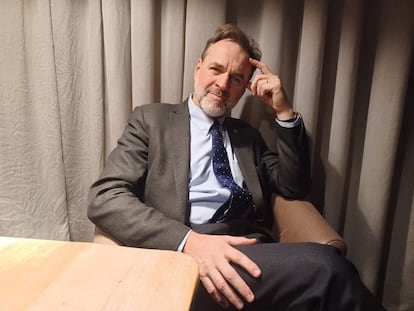Why sanctions on Russia haven’t caused its economy to collapse
The restrictions imposed on Moscow have reduced its military capacity, but after almost two years they have not caused the bankruptcy predicted by the West


“Russia is a gas station masquerading as a country,” the late U.S. Senator John McCain said in 2014. “It’s kleptocracy. It’s corruption. It’s a nation that’s really only dependent upon oil and gas for their economy, and so economic sanctions are important. It was the same year that the Kremlin illegally annexed Crimea and lit the spark of conflict in Donbas. At that time, symbolic sanctions were applied on Moscow. A decade later, two years into Russia’s war in Ukraine, the battery of restrictions employed against the Kremlin are much, much tougher, but they have not caused the country to succumb as was claimed, although they have curbed its war industry. The big threats for 2024 are inflation and the devaluation of the ruble.
McCain’s words still annoy the Kremlin. Foreign Ministry spokeswoman Maria Zakharova referred to them again this week, saying that it was a “Russophobic” statement, and accused the United States of “being a more complex gas station: one with a built-in money printer,” in reference to its monetary policy.
In the opinion of economist Vladislav Inozemtsev, founder of the Moscow Center for Post-Industrial Studies, that simplification by McCain sums up the great failure of the sanctions. “The main mistake of Western experts and politicians was to create fairy tales that the entire Russian economy is state-run,” the independent expert tells EL PAÍS by telephone. “Sanctions were applied on the assumption that it was a state-run economy that was not flexible and would therefore collapse quickly. But that was a mistake, because the Russian economy is very much a market economy.”
Russian military spending hovers at around 6% of gross domestic product (GDP), about the same percentage as during former U.S. president Ronald Reagan’s first term in office, from 1981 to 1985. “And no one would say that the American economy was a war economy,” says Inozemtsev, who stresses that the Russian public sector is concentrated in large enterprises with huge budget revenues, but in terms of employment is very small.
In contrast to the collapse of the USSR and its planned economy, “Russian private companies have found ways to survive in the face of sanctions and have embarked on creating new sales channels and supply chains,” Inozemtsev notes. For example, through illegal imports via non-Western countries.
Russian authorities forecast GDP growth of around 3.2% this year. “Three percent is an insufficient growth rate, it must be higher, everyone understands this, we need to compensate for many gaps,” Kremlin spokesman Dmitry Peskov recently acknowledged.
The Russian rating agency AKRA - Western ones no longer operate in the country - agrees with the Kremlin’s forecast for 2023, but predicts that Russian growth will stagnate to the 0.5%-1.3% range next year, compared to the 1.4% predicted by the Russian government. One reason is the inability to find workers (unemployment stands at 2.4%) due to military mobilization and the exodus of Russians and immigrants due to the war. The other is inflation and high central bank interest rates. “Most likely, household savings will increase,” the agency warns.
“2022 was a historically beneficial year for Russia”
Janis Kluge, an economics expert at the German Institute for International and Security Affairs, concludes in a detailed analysis published by the think tank Riddle that 2024 will be the litmus test for the Russian system after two years — 2022 and 2023 — that were rescued thanks to the reserves accumulated before the war and the extra income obtained at the beginning of the invasion through the shock in international gas and oil prices that the offensive provoked.
“2022 was a historically beneficial year for Russia, the economy is not always fair,” Kluge says. Moreover, the sharp devaluation of the Russian currency since the second half of 2023 (from 66 rubles to the dollar to 90 now) due to the low inflow of foreign currency has helped the Kremlin’s coffers, which pays its citizens in rubles and has thus solved — in addition to the redirection of its market to India and other countries — the cap on the price of Russian oil imposed by the West. “These are the reasons why the Ministry of Finance estimates the real deficit for 2022 and 2023 to have been 0.7% and 2.7% of GDP. The situation clearly worsened in 2023,″ Kluge notes.
Expenditures and revenues have increased by 10% over forecasts this year. Expenditures stand at around 33 trillion rubles but revenues have also risen to 28.7 trillion rubles. Comparisons with the dollar are meaningless because an average Russian salary — 52,000 rubles ($573) last summer according to the country’s main bank, Sberbank — has greater purchasing power in the Russian market than outside.
The problem for the Kremlin is that this devaluation may favor its military budget, but at the same time it increases the pressure on its population. “Thirty-five percent of products or the resources to produce them are imported,” Inozentsev explains. “The limit for the ruble to fall and inflation not to rise has been exhausted. The authorities will do everything in their power to keep the exchange rate at the current level. Unless they want serious inflation, which is what they fear,” notes the economist, who estimates an exchange rate of 115 rubles to the dollar this year if the situation is stable.
However, the Kremlin does not have everything under its control: despite OPEC+ cuts, in recent months, spurred by the Gaza war, the Brent barrel has fallen from almost $100 to $75. “Russia has become much more vulnerable to the ups and downs of oil,” says Kluge. “If prices fall, the ruble will devalue sharply and it will become increasingly difficult to protect the currency,” he says before emphasizing that this would entail huge spending cuts: “And in an era of soaring military spending, any fiscal consolidation will be even more painful for the population.”
The Russian government expects to end the year with an official inflation rate of 8%. According to the Rosstat statistics agency, prices of consumer goods rose by 6.7% between January and October. However, a study by the expert platform Romir puts the real increase in the cost of the shopping basket at 20.4% over that period, and at 47.9% since the beginning of the war in February 2022.
The Kremlin has imposed its monetary policy on the Russian central bank, which despite claiming that the devaluation of the ruble is due to the demand for dollars and euros, obeyed orders and raised interest rates to 16%. It has also taken risks such as lending rubles to the government with funds frozen by the West as a counterparty. In total, the money supply has increased by about 23% since the war began.
In the opinion of experts, some sanctions have worked, such as those on the airline industry, while others, such as those on hydrocarbons, have served their objectives half-heartedly. “What McCain said about the gas stations was terrible,” says Inozemtsev. “In fact, a big mistake was made here because a gas station is something essential, everyone passes by one every day. If they thought it was possible to deal a heavy blow to exports with sanctions, it was quite naive,” says the Russian economist, who concludes that “each new sanctions package provokes more and more controversy and less and less effect, so I would put an end to these talks and focus on financial and military support for Ukraine.”
Sign up for our weekly newsletter to get more English-language news coverage from EL PAÍS USA Edition
Tu suscripción se está usando en otro dispositivo
¿Quieres añadir otro usuario a tu suscripción?
Si continúas leyendo en este dispositivo, no se podrá leer en el otro.
FlechaTu suscripción se está usando en otro dispositivo y solo puedes acceder a EL PAÍS desde un dispositivo a la vez.
Si quieres compartir tu cuenta, cambia tu suscripción a la modalidad Premium, así podrás añadir otro usuario. Cada uno accederá con su propia cuenta de email, lo que os permitirá personalizar vuestra experiencia en EL PAÍS.
¿Tienes una suscripción de empresa? Accede aquí para contratar más cuentas.
En el caso de no saber quién está usando tu cuenta, te recomendamos cambiar tu contraseña aquí.
Si decides continuar compartiendo tu cuenta, este mensaje se mostrará en tu dispositivo y en el de la otra persona que está usando tu cuenta de forma indefinida, afectando a tu experiencia de lectura. Puedes consultar aquí los términos y condiciones de la suscripción digital.
More information

Two million Ukrainian civil servants face salary cut-off if Western aid dries up
Archived In
Últimas noticias
Venezuela hardens its ‘revolutionary state’ project amid pressure from Trump
Sydney Sweeney, the actress praised by Trump: ‘Women are up against what society wants them to be’
The Bolsonaro surname: An advantage or liability in Brazil’s 2026 presidential elections?
Raúl Rocha, from jet-setting with Miss Universe to arms trafficking and fuel theft
Most viewed
- Reinhard Genzel, Nobel laureate in physics: ‘One-minute videos will never give you the truth’
- Pablo Escobar’s hippos: A serious environmental problem, 40 years on
- Charles Dubouloz, mountaineering star, retires at 36 with a farewell tour inspired by Walter Bonatti
- Why we lost the habit of sleeping in two segments and how that changed our sense of time
- The fall of a prolific science journal exposes the billion-dollar profits of scientific publishing









































